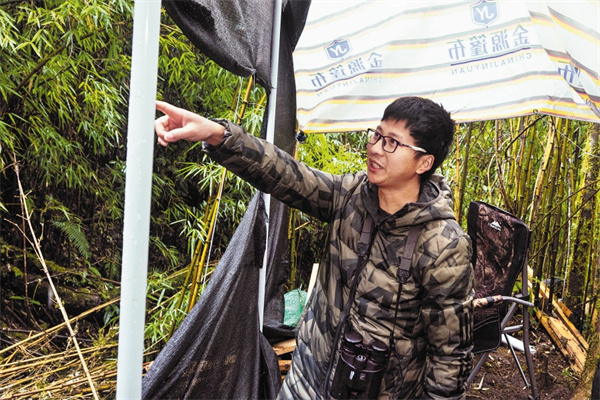Bird lovers flock to Xizang guesthouse
Updated: 2024-03-26 (China Daily)  Print
Print 


Avian enthusiasts swooping in to Metog to glimpse rare species

Chen Yangyang points to birds feeding at his bird hide by the Zhamo Highway in Metog county, Xizang autonomous region, on March 14. CHEN LIANG/CHINA DAILY
Known as the last county in China to be connected by highway, Metog in Southwest China's Xizang autonomous region has long been regarded as one of the most remote areas in the country.
Despite its isolation, many people from across the nation have found fulfilling careers, love and a sense of purpose in Metog, choosing to make it their home. Among them are Chen Yangyang and his father, Chen An.
In 1997, when Chen Yangyang was 6, his parents divorced. Chen An, a stonemason, decided to move to Xizang to find work at some construction sites, while Chen Yangyang and his mother remained in Suining, Sichuan province, their hometown.
Chen An found a job working on the construction of a highway connecting Metog with neighboring Bomi county. In 2000, he met a woman from the Monba ethnic group and married her. Together, they had two children, a boy in 2002 and a girl in 2004.
"He truly likes his new home in Metog," Chen Yangyang said.
To support his new family, Chen An farmed the land in the hilly hamlet where they lived, which is near the highway's 90-kilometer boundary marker. Also known as 90K, the marker indicated that it was 90 km from Zhamog town, the county seat of Bomi.
In addition to farming, Chen An also did various odd jobs along the highway, including bridge construction and stone masonry. Sometimes, he would also find work in the county seat of Metog, which is about 30 km from 90K and shares the same name as the county.
The year 2013 marked a turning point as the highway, called Zhamo (Zhamog-Metog), was finally completed. Zhamo starts from Zhamog and ends at the county seat of Metog, with a total length of 117 km.
In the summer of 2013, Chen Yangyang, then a student at Chengdu University, went to Xizang to visit his father's home in Metog.
"It was the first time I went to Metog," Chen Yangyang said. "Even though the place was quite backward compared to other parts of the country, I liked the weather there and enjoyed my stay."
After graduating in 2014, Chen Yangyang found work at a media company in Lhasa, the regional capital. In 2015, the government initiated a relocation project and moved Chen An's village to 80K, the area around 80-km marker. Chen An's family was given a plot of land to build their own house.
The construction of Chen An's new two-story house was completed in June 2017. Chen Yangyang suggested he use the surplus rooms to start a homestay business for tourists.
Chen Yangyang came to 80K in July 2017 and took charge of the business, but a project to upgrade the highway in 2018 made the area along the road a construction site again, which prevented tourists from visiting. He decided to return to Lhasa to work.
When the road project was completed in March 2020, Chen Yangyang returned to 80K and resumed running the homestay.
In June that year, he and his father rented part of a poverty alleviation building owned by the local government and moved their business to the building standing near the Zhamo Highway's 80K marker.
Entrepreneurs who rent spaces in the poverty alleviation building pay the local government an annual fee and keep whatever profits they make. Meanwhile, the government uses the money it earns from renting out the spaces to fund programs that aid other struggling locals.
Chen Yangyang's new guesthouse has 19 rooms on three floors, with a two-room restaurant on the ground floor.
Tourist visits were hampered again, though, this time by the COVID-19 epidemic that started in the winter of 2019.
"Business was quite slow in the beginning," Chen Yangyang said.
Birders land

The rusty-bellied shortwing is one of the "highlight" bird species that can be viewed from Chen's bird hide in the summer. CHEN LIANG/CHINA DAILY
With effective COVID-19 control measures in Xizang, business gradually picked up during the autumn and winter of 2020, particularly with the arrival of birders.
"I met the first group of bird watchers in late October 2020. They truly opened a window for my life and business," Chen Yangyang said. "I knew there were people willing to travel far to just watch birds, and Metog is one of the best bird watching destinations in the country."
That winter, dozens of bird-watchers visited Metog.
"Bird-watchers stop along the road and watch birds at different elevations. The 80K marker is one of their favorite places to spend a day watching birds," he said.
Because Zhamo Highway is a narrow mountainous road, the local government only allows cars to enter Metog on even-numbered days and leave the county on odd-numbered days, so bird watchers who come have to stay overnight in the area.
"As a result, they have become my primary customers," he said.
In October 2021, Huang Shigui, who leads a bird watching tour group, discovered a Mishmi wren-babbler, a bird species that is new to China, near 80K.
"He stayed at my guesthouse," Chen said. "I felt his excitement that evening and also saw the bird with him the next day."
However, the sparrow-sized bird was skulking while moving mainly near the ground in dense shrubbery, and they failed to get a photo of it. Huang suggested Chen keep an eye on the bird and try to photograph it.
In April 2022, Chen managed to see the bird again at the same location and snapped a photo.
"It was one of the first photo records of the bird in China," he said. "I was thrilled."
Soon, he captured the photos of another rare bird, a rusty-bellied shortwing.
"Many Chinese bird-watchers considered it a major find," he said.
Hide mentality

Chen An and his wife, Rinchen Chodron, in their home in Metog. CHINA DAILY
Earlier in 2021, some birders had suggested Chen build a bird hide, which would draw more enthusiasts to his guesthouse.
He built one on his family's farmland, but likely due to its location in an open area, few rare bird species came near it.
"It was a failed attempt," Chen said.
After discovering the wren-babbler, he decided to build another bird hide in a bamboo forest near a place frequented by the bird in early 2022.
By March of that year, rare birds began showing up at the hide. First, a Sikkim wedge-billed babbler appeared, then a rusty-bellied shortwing. Both highly secretive and shy by nature, they are elusive in their movements amid dense under-forest vegetation, making them difficult to be spotted in the wild.
"The Mishmi wren-babbler was in the area but never showed up around the hide," Chen said. "But the shortwing became a regular visitor in the summer, and the wedge-billed babbler visited almost every day. For birders across the country, the two species have become my bird hide's major attractions."
Last year, he said that about 300 bird-watchers visited his hide. The revenue generated from the bird hide amounted to over 20,000 yuan ($2,780), while income from accommodations and dining at the guesthouse exceeded 40,000 yuan.
Last year during summer and autumn, which is the off-season for birders, the guesthouse also provided long-term accommodations for construction workers, he said.
In 2015, while working in Lhasa, Chen met his future wife, a native of Chongqing.
They met when she visited Metog for a hiking trip in 2017, and after subsequent meetings they fell in love. They married in 2020 and had a daughter in 2022.
The family of three have settled in Metog.
"Besides limited access to express delivery and some fresh fruits, Metog is comfortable, especially the climate," he said.
Last year, they purchased a secondhand car in Chongqing and rented two more rooms in the building that are conjoined to open a cafe.
"Bird watchers can relax in the cafe after a long day in the wild," he said.
chenliang@chinadaily.com.cn








